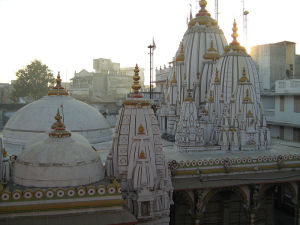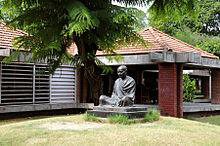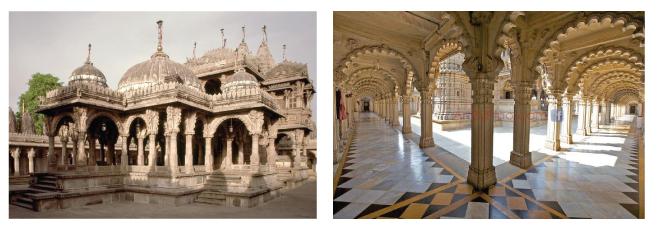Our Destination
Ahmedabad, Gujarat, India
Ahmedabad is the sixth largest city (pop. 6.5 million) in India. It is the commercial hub of the state of Gujarat, though it is not the state capital, which is its twin city Gandhinagar, 30 km to the north, the city was founded by King Karandev in the 11th century and originally called “Karnavati”. The Hindu kingdom of Karnavati ruled for more than 400 years until 1411 when Sultan Ahmed Shah conquered Gujarat and the city was renamed Ahmedabad after him. The city was built in open and spacious plains to the East of Sabarmati. It was comprised of a smaller known Fort as Bhadra. The city fort wall was enclosed containing 12 Gates. The city of Ahmedabad went on expanding in every direction by the addition of new areas on the sides of the river, with well laid out beautiful buildings, lakes and mosques.
In 1753 the combined armies of Raghunath Rao and Damaji Gaekwad took the fort, which resulted in the end of Mughal Rule in Ahmedabad. In 64 years during the rule of Gaekwad and Peshwa, the city became cleaner. In 1818 the British annexed Ahmedabad. During this period the municipality committee was founded and a railway link was established.
The British restricted themselves to the cantonment area and didn’t take much interest in the city. Nor did they get around to colonizing Ahmedabad culturally; they didn’t set up schools, churches and clubs all over the city, the way they did in other cities.
Ahmedabad was a cradle of the non-violent movement for India’s independence, being host to the Sabarmati ashram of Mahatma Gandhi. Ahmedabad poses a mixture of rich tradition and modern feel. Ahmedabad is famous for the Navaratri festival. It’s considered to be the longest dance festival on earth.
The Gujarati community is largely known for its hospitality and for being shrewd businessmen. Ahmedabad is a big industrial city long reputed for its textile industry, and today more so for its chemical, petroleum, international trade & IT industries. It is also well known for the Finance Wizards and as the modern hub of Jain Religion.
The city has been put on world map by institutions like Indian Institute of Management – Ahmedabad and Indian Institute of Technology, Gandhinagar, the place has become a landmark for good education practices. Institute of Design, Pandit Deendayal Petroleum University (PDPU), Dhirubhai Ambani Institute of Information & Communication Technology, IHM, MICA, EDI, Nirma University, Gujarat Law society, Swaminarayan Gurukul, CEPT (Centre for Environmental Planning and Technology) University, NIFT and a few others.
Important Places to see include:
Shri Swaminarayan Temple
This temple is known for the Green and yellow sculptures of Hindu gods and goddesses, their bodies fitted in opulent dress, cover the structure of this nineteenth-century temple. With its architecture based on Burma teak wood, every coloured arch and bracket is a bright different shade, something that stands out in most Swaminarayan temples. The temple resembles a fairytale with all its colours and opulent carvings that profusely embellish every wooden bracket, column and arch. The temple attracts a million people on the day after Diwali. The temple has a multi-story guesthouse that is air conditioned and has a fully equipped medical clinic within its compound.
Gandhi Aashram
The Sabarmati Aashram was once house of Mahatma Gandhi. The ashram was founded by Mahatma Gandhi in 1915, and today without doubt, it is the biggest tourist attraction in Ahmedabad. It lies on the tranquil stretch of the Sabarmati river and was referred to as the Satyagraha Ashram during the lifetime of the Mahatma. It was from here, that the Mahatma began his famous ‘Dandi March’ in 1930 to protest against the Salt Tax imposed by the British. One can see the three wise monkeys and many more of Gandhiji’s teachings at the ashram premises.
Juma Masjid
It is amongst the most popular tourist sights in the city. Built of yellow sandstone this mosque stands on 260 pillars which support 15 domes at varying elevations. The mosque was built by Ahmad Shah in 1423. It is easily accessible as it stands in the centre of the old city. This imposing structure reflects the Muslim architecture of that period.
Hathi
Hathi Singh Jain Temple
An impressive white structure, the Jain temple built of white marble and elaborately carved is dedicated to Dharmanath – the 15th Jina or Jain Apostle. Similar to all Jain temples, this temple to is rich in intricate carvings.
Adalaj Step-Well
Adalaj is a village 18km to the north of Ahmedabad. The step-well derives its name from the lady patron, Ruda, wife of the Vaghela chief, Virsinh; who built it in the 15th or 16th century A.D. It is the only major monument of its kind, which has three entrance stairs leading to the stepped corridor. These three entrances meet in the first floor, underground, in a huge square platform, which has, to the top, an octagonal opening. The platform rests on 16 pillars, on the corners, and two in front of each side.
The four corners of the platform are marked by four built-in shrines, with doors, windows, balconies. The stepped corridor begins from this square platform. The corridor is entirely surrounded by a one-metre high parapet with a rounded topping. It descends with four pavilion towers for five storeys. The walls of the Vav are veritable show cases of sculptures and ornamentation. The sculptures range from a king sitting on a stool under a parasol, to erotic scenes; and buttermilk churning girls. The door frames around the entrances of the spiral staircases to the octagonal shaft are surrounded by a parikrama, which is an enlarged version of the frames around the niches. String-courses running along the side walls embellish all parts of the structure, sometimes dividing the wall into horizontal sections. They also appear on the walls of the octagonal shaft, depicting floral or leaf patterns, or rows of animals. The five-storied, step-well located in the sleepy village of Adlaj is a marvel of architecture. This unique water work is an excellent blend of Hindu and Islamic styles.
Many Other Educational Attractions Include:
Calico Textile Museum. One of the finest textile museums in the world in one of Gujarat’s famous carved wooden havelis. The museum displays a magnificent collection of rare textiles dating back to the 17th century. There is also an excellent reference library on textiles. Located in the Sarabhai Foundation, in Shahibagh the Calico Museum of Textiles, widely regarded as one of the finest textile museums in the world was constructed in 1949. It has the finest collection of not just textiles and clothes but also furniture, temple artifacts and crafts in the country. It has no less than five centuries of the finest fabrics spun, woven, printed and painted in different parts of India. It has a collection of marble, sandstone and bronze icons and busts split in two thematic sections- gallery for religious textiles and historical textiles. An excellent reference library on textiles is found here.
Indian Institute of Management (IIM), one of the best B-School of Management is wonderful architectural creation.
Veechar Utensil Museum, the only museum in the country showcasing over 3,000 utensils used by the various households in India. It’s a personal collection of Mr. Surendra Patel who has curated and designed the museum. The museum is a part of Vishalla, a restaurant serving ethnic Gujarati Food. It’s a magnificent museum showcasing a very different culture of India.
National Insitute of Design, India’s Premier Design Institute with over 16 disciplines of Design. Husain Doshi Gufa, called Amdavad ni Gufa. Times: 4 to 10 pm evening. There is a Kanoria Gallery of Art and Vikram Sarabhai Science Musuem for children in one walkable area (Say Gujarat University area). Best of all there s no Entry fee. This place has some fantastic open air eatables in makeshift vans especially around Navrangpura Commerce Six Roads L D Arts Lane.
Auto World Vintage Car Museum, Shri Pranlal Bhogilal is a connoisseur of vintage cars. He has converted his private collection of vintage cars into a museum named Auto World Vintage Car Museum at Dastan Farm House. The Museum has a collection of more than 100 cars. The cars are amazing and lovely. One could find all the best cars of the world – Rolls Royce, Bentley, Maybach, Jaguar, Cadillacs, Austin, Chrysler, Lincoln, Ford and many many more. Each car is in a perfect driving condition. In fact, you can even drive them by paying a hefty fee – Rs 500 ($10) for 3.5 km drive in a historic car.
Darpana Academy of Performing Arts, is one of the oldest performing arts academies in the city. Its amphitheater Natarani has a fabulous performance venue overlooking the Sabarmati river and is one of the few places to bring internationally acclaimed performing artists to the city.
Ahmedabad Metal Scene, One of the best underground metal scene, unknown to residents of gujarat.
Lalbhai Dalpatbhai Museum, It is one of the best arts displaying museum in city. It has a wide collection of Indian miniature paintings, stone sculptures, terracotta, paintings of Tagore, art of Nepal and Tibet, bronzes, textiles, wood work, cloth paintings, metal sculptures and coins.
Institute of Indology, Lalbhai Dalpatbhai Institute of Indology was established in Ahmedabad by Muni Shri Punyavijayji and Shri Kasturbhai Lalbhai. The museum houses priceless collection of books, manuscripts and other reference material from ancient India.The museum is a treasure trove of manuscripts relating to Jainism. In all there are about 45,000 printed books with 75,000 manuscripts including out of which 500 are illustrated ones. These documents from the past cover a wide range of subjects like Vedas, Agamas, Buddhism, Tantras, Jain Darshana, System of Indian Philoshy, Jaina Philoshpy, Grammer and Poetics etc.The institute has also published seven volumes of catalogues in languages like Hindi, Sanskrit, Old Gujrati, Prakrit and Rajasthani. The institute also conducts periodical workshops on manuscriptology and paleography. It can be learning experience if you get to attend these workshop.
Swaminarayan Gurukul, It is a residential and day boarding school run by the Swaminarayan faith of Hinduism. The infrastructure and the education systems are worth watching. On the first look of the main school building, you may feel that you are visiting some ancient palace of a powerful king. The school teaches not only formal education but also provides training in horse-riding, archery, dairy development, Yoga, Ayurveda, etc.
S. G. Highway, or Sarkhej – Gandhinagar Highway, the recently developed hub of entertainment in Ahmedabad, is worth putting in couple of evening for. From fun and movies at Fun Republic and Wide Angle or R-World to temples like Mini Vaishnow Devi Temple and ISKON temple, you will find almost everything that you need for entertainment. A few min walk straight from Vaishnow Devi temple you’ll find ‘Boot camp’ Ahmedabad’s first and only outdoor recreational facility that has activities like Paint Ball shooting, Archery, Dirt biking etc. The same highway leads you to Gandhinagar as well, where you can visit Akshardham temple and many other places of interest.
Dada Hari ni Vav (step well) in Asarwa. Next to this there is Mataji ni Vav (also a step well). Vavs are the thing that can be experienced when days get hotter, it is cooler inside a step well… yet to be filled with water and waiting for rain… whether it rains or not it is cool in there. It is a small rikshaw ride in a narrow lane right next to behind Hutheesingh Jain Temple
Sidi Sayed Mosque, Sidi Sayed Mosque is unique for its exquisite screens, which are praised for their amazing Jhali screen, framed, in the ten semi-circular windows. The screen carved out of one rock is just exceptional. A visit to this superb a nd outstanding example of delicate carving is an absolute must.
Jhulta Minara, Quite an unusual structure, Jhulta Minara or swaying minarets are a part of the mosque of Siddi Bashir and can be moved back and forth by applying a little force at the topmost arch. One of the minarets was partly demolished by an Englishman in his endeavors to unravel the mystery of the swaying minarets. The mosque was built by master craftsmen and the crucial mechanism that leads to the vibration is still a mystery. The other interesting fact here is that these minars stand the test of the rumbling trains that pass not very far away from them.
Bhadra Fort, To add special charm to the varied sights of the city there is the Bhadra Fort, which once housed royal palaces and well-laid gardens. It boasts the temple of Bhadrakali and was built in 1411 during the Maratha rule.
Heritage Houses of poles, A living heritage, the structures are 100-600 years old and the people living in there are original ahmedabadi traditional families. Must visit pol’s 1 – Dhobini pol haveli no:1765 2 – Desai ni pol row of houses 3 – sutharwada ni pol 4 – Jethabhai ni pol 5 – wagheswar ni pol 6 – Sankadi sheri. for more details visit http://www.vaarso.com
Akshardham Temple, Rich and Wonderful architecture. Located in Gandhinagar, about 20 km from Ahmedabad. Temple will be closed on Monday. Other days you can visit from 10 to 6
Science City, Newly built Science City is one latest happening place in the city
Vaishnodevi Temple, Replica of famous Vaishnodevi temple located at Sola Gandhinagar Highway.
Amar dham, This religious site is known for its architectural grandeur.
International Society for Krishna Consciousness (ISKCON) temple, This Hindu temple depicts Krishna, and his lover, Radha, who is regarded as the personification of love.
Kankaria Lake. A circular lake built in 1451 by Sultan Qutub-ud-Din. In the centre of the lake is an island garden with a summer palace known as Nagina Wadi. It has a very beautiful Musical Fountain show (although the music isn’t too good, the lights and fountain are worth a trip). The lake is a popular recreation centre surrounded by parks, ‘Bal Vatika’ – an aquarium, a boat club, a natural history museum and a zoo.
Kamla Nehru Zoo This is near to Kankaria Lake and one of the best zoos in India.
Vastrapur Lake. Newly constructed artificial lake.
Law Garden, Considered the main centre of activity in Ahmedabad, one can purchase handcrafts and traditional Gujarati outfits, amongst other things.
Sarkhej Roja, This is a small city located 10km southwest of Ahmedabad. It is widely known for its architectural complexes.





